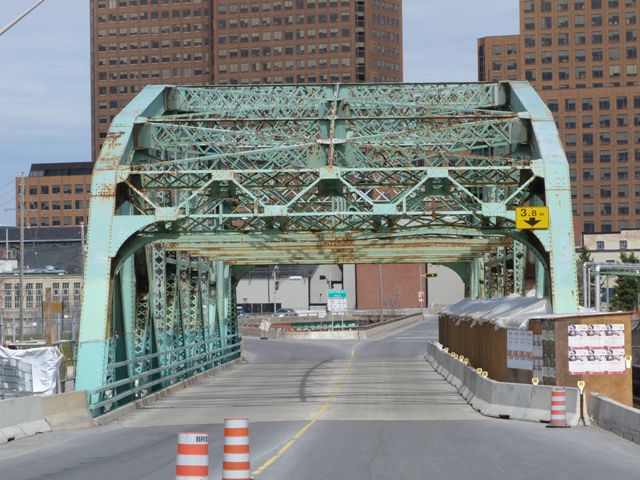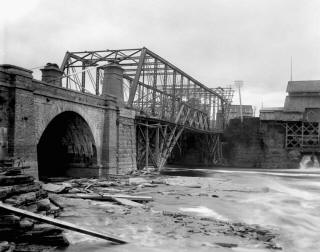We Recommend:
Bach Steel - Experts at historic truss bridge restoration.
BridgeHunter.com Phase 1 is released to the public! - Visit Now
Chaudière Bridge (Pont Chaudière)

Primary Photographer(s): Nathan Holth and Rick McOmber
Bridge Documented: April 13, 2011
Rue Eddy (Booth Street) Over Ottawa River (Rivière des Outaouais)
Ottawa and Gatineau: Ottawa City, Ontario and Outaouais, Québec: Canada
Metal 12 Panel Rivet-Connected Pennsylvania Through Truss, Fixed and Approach Spans: Stone Semicircular Deck Arch, Fixed
1919 By Builder/Contractor: Dominion Bridge Company of Montréal, Québec
2011
238.2 Feet (72.6 Meters)
Not Available
Not Available
1 Main Span(s)
Not Applicable

View Information About HSR Ratings
Bridge Documentation
This bridge is an excellent example of a truss bridge displaying the Pennsylvania configuration, an uncommon configuration. Built in 1919, the bridge displays the massive members that would become common in truss bridges built after 1920. The massive members reflect a trend to bridges carrying heavier loads with wider roadways as well, which both require heavier truss construction.
This bridge is located at a historical crossing that has been home to a number of bridges. Photographs showing three previous bridges with the oldest dating back to 1828 are available on this page.
Also of interest is the approach system for this bridge. The centerpiece of the approach system is the span located immediately north of the truss, which is an 1828 stone arch span from the first bridge at this location. This arch span has been significantly altered from its original construction. The bridge was widened when the current truss bridge was built. Normally, alterations are something undesirable on a heritage bridge, but in this case the alteration is so old the alteration itself is interesting. The widening was accomplished by adding a riveted girder to the side of the arch, which allowed the deck to be extended. The original parapets were removed. North of this span, the roadway splits into two structures to cross the remainder of the waterway, before coming back together at the northern end of the bridge. The western (southbound) half of this portion of the bridge includes another stone arch span from the 1828 structure. The eastern (northbound) half of this portion of the bridge includes a riveted girder structure that may have been built in 1919 at the same time as the truss bridge. This bridge crosses the channel at a severe skew. Made possible by the unusual angle at which it crosses the channel here, the bridge's piers are an unusual design that consists of massive truss boxes that span the entire river channel, preventing the need for the piers to be placed in the water. The bridge spans rest upon these unusual truss boxes.
This bridge was being rehabilitated when HistoricBridges.org visited it. As such, photographs are limited.
Above: Photo showing previous 1892 bridge under construction. This bridge was an iron pin-connected Whipple through truss.
Source: Topley Studio / Library and Archives Canada / PA-033945
Above: ca. 1870 view of the cable suspension bridge that preceded the 1892 bridge. This bridge lasted from 1844-1889 and was called Union Suspension Bridge.
Source: Bibliothèque et Archives nationales du Québec Reference Number P600,S6,D5,P1323
Wooden truss bridge that preceded the suspension bridge and dated to 1828 and was called Union Bridge. The bridge also included approach spans including the stone arch spans that can be found today.
Source: Library and Archives Canada Reference Number Acc. No. 1936-60-1
![]()
Photo Galleries and Videos: Chaudière Bridge (Pont Chaudière)
Bridge Photo-Documentation
Original / Full Size PhotosA collection of overview and detail photos. This gallery offers photos in the highest available resolution and file size in a touch-friendly popup viewer.
Alternatively, Browse Without Using Viewer
![]()
Bridge Photo-Documentation
Mobile Optimized PhotosA collection of overview and detail photos. This gallery features data-friendly, fast-loading photos in a touch-friendly popup viewer.
Alternatively, Browse Without Using Viewer
![]()
Southbound Crossing
Full Motion VideoStreaming video of the bridge. Also includes a higher quality downloadable video for greater clarity or offline viewing.
![]()
Maps and Links: Chaudière Bridge (Pont Chaudière)
Coordinates (Latitude, Longitude):
Search For Additional Bridge Listings:
Additional Maps:
Google Streetview (If Available)
GeoHack (Additional Links and Coordinates)
Apple Maps (Via DuckDuckGo Search)
Apple Maps (Apple devices only)
Android: Open Location In Your Map or GPS App
Flickr Gallery (Find Nearby Photos)
Wikimedia Commons (Find Nearby Photos)
Directions Via Sygic For Android
Directions Via Sygic For iOS and Android Dolphin Browser





